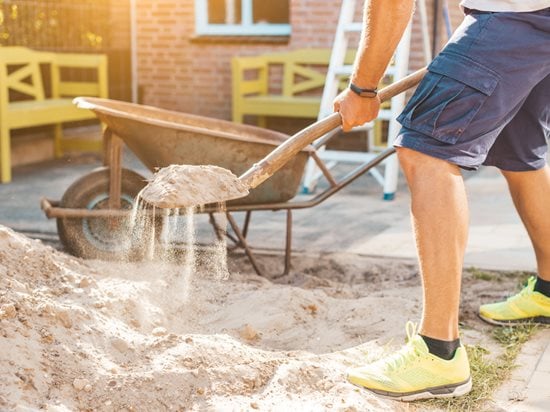- Staining Concrete
- Stamped Concrete
- Concrete Overlays
- Concrete Resurfacing
- Concrete Polishing
- Concrete Dyes
- Colored Concrete
- Indoor Concrete
- Concrete Floors
- Concrete Countertops
- Garage Floor Coatings
- Furniture, Sinks, Fire Bowls
- Basement Floors
- Outdoor Concrete
- Concrete Patios
- Concrete Driveways
- Concrete Pool Decks
- Outdoor Kitchens & Counters
- Outdoor Fireplace
- Concrete Walkways
- Concrete Pavers
- Concrete Walls
- Repair & Maintenance
- Foundation Repair
- Concrete Crack Repair
- Concrete Sealers
- Building with Concrete
- Concrete Homes
- Concrete Basements
- Decorative Concrete
- Fire Resistant
Does Dry Pour Concrete Work & Is It Strong Enough to Last?
See how dry pouring concrete is done and why this shortcut can lead to weak, unreliable slabsDump bags of prepackaged concrete mix directly onto a prepared subgrade, spray down with water, and voila: Your own DIY concrete slab. This unconventional concrete placement technique, which is trending on YouTube and other social media platforms, is being touted as an easy, time-saving alternative to the typical method of mixing the concrete with water beforehand. But as with most shortcuts, if it sounds too good to be true, it is.
Find concrete contractors near me.
Although dry pouring of concrete might be fine for filling fence-post holes, it should be avoided as a placement method for concrete slabs if you want the concrete to look good and last for the long term. Here are the reasons why.
Dry pouring vs. wet pouring of concrete
With dry pouring, the step of mixing the concrete with water before placement is completely eliminated (see How to Mix Your Own Concrete). Instead, bags of preblended concrete mix (such as Quikrete or Sakrete) are simply dumped into forms directly onto a dampened subgrade and leveled off with a heavy steel rake or screed The dry concrete is then moistened with water over a period of several hours by misting with a hose, which allows the water to slowly soak through the slab. To ensure adequate curing, the concrete is then covered with plastic and kept moist for at least 7 days.
How does dry pouring impact concrete strength?
Mixing concrete properly involves careful measuring of its three key components: portland cement, aggregate, and water (see Concrete Mix Materials). Using the right water-cement ratio is especially critical to achieving the proper concrete consistency and optimum strength.
Although prepackaged concrete mixes instruct you to “just add water,” it must be added in the proper proportions and mixed in thoroughly by hand or with a concrete mixer to ensure there are no dry pockets, which can compromise the overall quality and durability of the finished product.
With dry pouring, there is no way to determine if the concrete is saturated completely or to calculate the water-cement ratio. What’s more, dry-pour concrete may not be able to withstand the stresses and strains of frequent freeze-thaw cycles as well as wet-mix concrete.
Pouring a DRY vs WET Concrete Slab /// Cutting Them Open AFTER 90 days!!
Can you use dry pouring for small-scale projects?
Dry pouring of concrete might be acceptable for small slabs that won’t bear much weight and where the appearance of the surface doesn’t matter, such as the floor of a tool shed or the base for an air-conditioning unit. But for any project where the load-bearing capacity of concrete is important and reinforcement is required to boost tensile strength, such as a concrete driveway or sidewalk, it is not a viable option. What’s more, dry-pour concrete may not be able to withstand the internal pressures caused by frequent freeze-thaw cycles, making it a poor choice for slabs in cold climates.
Can you give a dry-poured slab a decorative finish?
Your decorative options with dry-poured concrete are very limited. It can’t be integrally colored, since the color must be mixed into the concrete, and it is not suitable for stamping. However, you can give the surface a textured finish while still damp to the touch by using a stiff-bristled broom or a texture roller.
Many decorative concrete contractors have reservations about the dry pour trend, here's why:
- They prioritize delivering high-quality, durable, and visually appealing concrete surfaces.
- Their concerns include compromises in strength and long-term durability.
- Limited decorative options and potential costly repairs or replacements are additional factors.
- Some contractors express curiosity but approach the trend with caution.
- Traditional wet-mix concrete methods are seen as essential for optimal results and longevity.
Is dry pouring a concrete slab an easy DIY project?
Although pouring your own concrete slab—either by wet or dry methods—may look like a simple DIY project, it can easily turn into your worst nightmare if you don’t know what you’re doing (see Common Mistakes When Pouring a DIY Concrete Slab).
Dry pouring does eliminate the step of mixing the concrete first, but you still have to prepare the subgrade, set up the formwork, and use a screed to level off the dry concrete before spraying it periodically with water, so very little time is saved overall. Plus, it’s usually more convenient to place wet-mixed concrete directly into the forms from a wheelbarrow rather than hauling and dumping each bag of dry mix individually.
Final words of advice
If you want to experiment with dry-pour concrete, do so with the understanding that your slab may not last long-term or provide the structural support you need. You’re always better off mixing your concrete with water beforehand, in the proper ratios, or ordering your concrete from a ready mix supplier (see How to Order Ready Mixed Concrete). That’s the only way to ensure that your concrete will perform as intended.
It is important to keep in mind that dry-pour concrete may not offer the same level of strength and durability as wet-mix concrete. Dry-pour concrete can also be more prone to cracking and shrinkage, which can lead to structural issues and the need for costly repairs over time.





